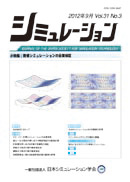Volume 4, Issue 3
Displaying 1-6 of 6 articles from this issue
- |<
- <
- 1
- >
- >|
Paper
-
2012Volume 4Issue 3 Pages 62-70
Published: 2012
Released on J-STAGE: December 05, 2012
Download PDF (1866K) -
2012Volume 4Issue 3 Pages 71-80
Published: 2012
Released on J-STAGE: December 05, 2012
Download PDF (1640K) -
2012Volume 4Issue 3 Pages 81-95
Published: 2012
Released on J-STAGE: December 15, 2012
Download PDF (1453K) -
2012Volume 4Issue 3 Pages 96-106
Published: 2012
Released on J-STAGE: February 06, 2013
Download PDF (1683K) -
2012Volume 4Issue 3 Pages 107-115
Published: 2012
Released on J-STAGE: February 16, 2013
Download PDF (1369K) -
2012Volume 4Issue 3 Pages 116-125
Published: 2012
Released on J-STAGE: February 21, 2013
Download PDF (929K)
- |<
- <
- 1
- >
- >|
